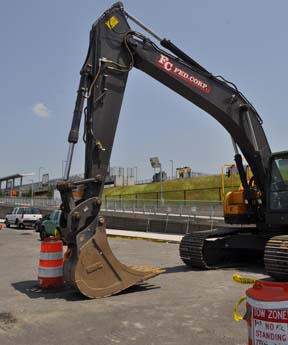July 31, 2013
 Construction work wrapped up at Newmarket station last month: Not enough locals, minorities or women on the job, says one watchdog. Photo by Bill ForryThe good news: After years of community advocacy, planning, and pushing, Dorchester neighborhoods now have easy rail access to downtown through the opening of three new stations on the MBTA Fairmount commuter rail line.
Construction work wrapped up at Newmarket station last month: Not enough locals, minorities or women on the job, says one watchdog. Photo by Bill ForryThe good news: After years of community advocacy, planning, and pushing, Dorchester neighborhoods now have easy rail access to downtown through the opening of three new stations on the MBTA Fairmount commuter rail line.
The bad news: The MBTA did not abide by local hiring standards for the construction work on the line. A victory for transit equity wrapped in a defeat for Boston’s workers. How did this happen?
Three new stations on the Fairmount Commuter Line — the Four Corners/Geneva Avenue station, the Talbot Avenue station and the Newmarket station —serve neighborhoods of the city that have been underserved by public transportation for decades.
Residents of these already low-income neighborhoods routinely have had to spend more money and an additional 90 minutes daily on commuting as a consequence. So the new transit lines, and their new lower fares (reduced to $2 from $5.50) are tremendous victories in transit equity. Every one of the many groups and individuals that worked together to make this happen deserve major kudos for helping bring these benefits to the community.
It’s because of these community benefits that I hate to put a damper on such amazing projects. However, while all three excelled in winning transit equity, at least one, Newmarket, failed to offer an equitable number of construction job opportunities to Boston residents, to minorities, and to females and minority/women owned businesses.
The MBTA spent $7.6 million on its construction, money that came into the agency from local taxpayers and went out to a general contractor in New Hampshire, S&R Construction Enterprises. Furthermore, the contractor did not have to follow the Boston Residence Jobs Policy goals (50 percent Boston residents, 25 percent minority, 10 percent female) and was only held to the Commonwealth’s goals — which has no threshold for local l residents, but calls for 15.3 percent minorities, and 6.9 percent women. Because the MBTA is a quasi-public “authority,” they were able to deny Boston workers their fair share of the construction jobs. Needless to say, they also didn’t consider the goals in the Roxbury Master Plan: 51 percent Boston residents, 51 percent minorities and 15 percent female.
The project only hired two firms from the city and 24 from the state from a pool of roughly 36. Who did work on this project? Firms from New York, New Hampshire, New Jersey, Rhode Island, Maine, Ohio, Wisconsin, and even Quebec, Canada!
To do better next time, we need to increase the return on these infrastructure investments for local communities. Let’s hold the MBTA accountable to local hiring standards on future projects so that Boston’s residents, minorities, females, and minority/women owned businesses are represented in the contracting process.
And then that new rail line can bring both the people to work and work to the people.
Travis Watson is a senior organizer and communications manager for the Dudley Street Neighborhood Initiative and a member of the Boston Employment Commission, which oversees the Boston Residents Job Policy.


